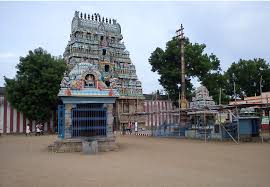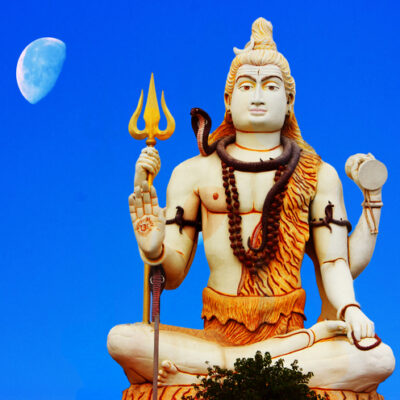Thirunageswaram Sri Nageswaraswamy Temple, Thanjavur

Address
Thirunageswaram Sri Nageswaraswamy Temple, Thirunageswaram, Kumbakonam Taluk, Thanjavur District, Tamil Nadu-612 204. Tele: +91- 435-246 3354, 94434 89839.,0435-2430349
Diety
Nageswara, Naganathar, Sankankaranarayeswarar Amman: Gujambigai (Parvathi)
Introduction
Tirunageswaram Naganathar Temple also known as Rahu Stalam is a Hindu temple dedicated to the deity Shiva, located in Tirunageswaram, a village in the outskirts of Kumbakonam, a town in Tamil Nadu, India. It is significant to the Hindu sect of Saivism as one of the temples associated with the nine planet elements, the Navagraha Stalas, and specifically Rahu. Shiva is worshiped as Naganathar, and is represented by the lingam. His consort Parvati is depicted as Piraisoodi Amman. The presiding deity is revered in the 7th century Tamil Saiva canonical work, the Tevaram, written by Tamil saint poets known as the nayanars and classified as Paadal Petra Sthalam. It houses four gateway towers known as gopurams. The temple has numerous shrines, with those of Naganathar, Rahu and Piraisoodi Amman being the most prominent. The temple complex houses many halls; the most notable is the ornamental entrance hall built during the Nayak period. Thala Virutcham : Shenbagam Theertham : Surya theertham
Puranic Significance
According to legend, Lord Shiva had asked Goddess Parvathi to go to earth and perform penance because she had punished Sage Birunki severely. Lord Shiva also told her that Goddesses Lakshmi and Saraswathi will accompany her. Goddess Parvathi selected this place (Thirunageswaram) to perform her penance. Pleased with her penance, Lord Shiva blessed her with his darshan and took her back to Mount Kailash. Goddess Parvathi is praised here as Sri Girigujambal. Her idol is also believed to be “Swayambu”. All the “Ashtamaha” serpents – the eight great serpents- (Ananthan, Vasuki, Thatchakan, Karkodakan, Sankapalan, Kulikan, Padman and Mahapadman) along with Adhiseshan worshiped the lord here. Adhiseshan came from the “Padhala logam” (underworld) and visited this place. Hence, Lord Shiva here is praised as “Thiru Nageswarar” (“Nagam” means snake and “Nathar” means the lord in Tamil) and the place gets the name Thiru Nageswaram. In his hymn, Saint Thirunavukkarasar mentioned that this lord was worshiped by the five-headed serpent. The legend of this temple also finds a mention in the “Samudra Manthan” episode in Hindu mythology. After extracting the nectar from the “Thiruparkadal” ocean, it was distributed among all the devas. Raahu also took a portion of the nectar. However, when Lord Mahavishnu realised that Raahu was the son of a demon woman, he severed his head. Raahu prayed to Lord Shiva for forgiveness. It is believed that Lord Shiva is restored him back to life by placing the severed head on a snake’s body. Lord Shiva also blessed him and gave him a place among the nine planets. Raahu is believed to have worshiped Lord Shiva here. Normally, Raahu appears in a snake form with human head in other temples but here he has a separate shrine. In this shrine, the idol is depicted in a human form. Also, this is the only place where the idol of Raahu can be seen with his consorts – Nagavalli and Nagakanni.
Special Features
This is one of the 276 Devara Paadal Petra Shiva Sthalams and 29th Shiva Sthalam on the Southern bank of the river Cauvery in Chozha Nadu (Thenkarai). Lord Shiva in this temple is a Swayambumurthi (self-manifested). This is one of the 44 Paadal petra sthalams where the “Moovar” (the three saints – Saint Thirugnanasambanthar, Saint Thirunavukarasar (Appar) and Saint Sundaramurthy (Sundarar) had rendered their Pathigams. This is a very famous “Parihara Sthalam” for Raahu dosham. This east facing temple has three corridors and its main tower (Rajagopuram) has 5-tiers. There are 6 other towers (Gopurams) in this temple. The last consecration ceremony (Maha Kumbabishekam) took place on 15.08.2005. The temple is another masterpiece which exhibits the Chola style of architecture. It is believed to have been built by Aditya Chola I in the 10th century A.D. Later rulers have modified the temple with their own additions. The temple has a separate shrine for Rahu. The temple is located on the southern bank of the river Kaveri 7 km from Kumbakonam. The temple campus encompasses exclusive shrines for Naganatha Swamy (Shiva), Pirayani Amman (Parvathi), Giri-Gujambigai (Parvathi) and Rahu with his divine spouses. Goddess Girigujambal has a separate shrine inside the temple campus as it is believed that the goddess is in thava kolam (mode of deep penance). The temple covers an area of 630 ft (190 m) South-North and 800 ft (240 m) East-West with concentric sub lanes and four major streets around the four sides. There are four gateways along the four sides with entry towers (gopuram) and a surrounding compound wall. In the broad pathway on the third precinct, there is a flower garden on the northern side. The Vinayaka shrine, Bali Peetam, Nandikeshwara hall and flag post are located in the eastern entrance. This Ganapathy shrine is said to have been installed by the great saint Sadasiva Brahmendra along with a Ganapathy yantra. An inscription in the temple bears testimony to this fact. The temple tank is called Sula Theertham, a dip in which, is believed to clear sins committed by human beings. The temple tank is located in the southern side and has a hundred pillared hall.The second precinct has a granite floor and enshrines the Rahu shrine in the north eastern corner. The path leading to the main shrine in the second precinct has a hall decorated with Nayak style pillars with yalis. The hall was constructed by Govinda Dikshitar, the minister of successive Nayak rulers, Achuthappa Nayak (1560–1614) and Raghunatha Nayak (1600–34). In the front hall on the eastern side, artistic pillar with “older and nine horses” design is found, while similar pillars are found on the southern side as well. There is a hall in the northern side with pillars decorated with yalis used for staging idols during the festive occasions. The renovation work in the western walls was done during 1929 with artistic inscriptions. In the path way to main shrine, there are art works depicting Veda nayakas, king Sambumali and penance pose of Ambal. The Dwarapalaga images on each side at the entrance of Naganathar shrine are made of chunam clay.
Festivals
10-day Brahmmotsavam in the Tamil month of Karthikai (Nov-Dec) and Saint Sekkizhar festival in the Tamil month of Vaikasi Poosam star day. Vinayakar Chaturthi in the Tamil month of Aavani (Aug-Sept), Thiru Karthikai in the Tamil month of Karthikai (Nov-Dec), Thiruvadhirai in the Tamil month of Markazhi (Dec-Jan), Masi Maham and Shivarathri in the Tamil month of Masi (Feb-Mar) and Panguni Uthiram in the Tamil month of Panguni (Mar-Apr). The transition days of the Raahu planet are also celebrated here with special poojas. Pradosham is also observed regularly.
Century/Period/Age
1000-2000 years old
Managed By
Hindu Religious and Charitable Endowments (HRCE)
Nearest Bus Station
Thirunageswaram
Nearest Railway Station
Thanjur
Nearest Airport
Trichy









